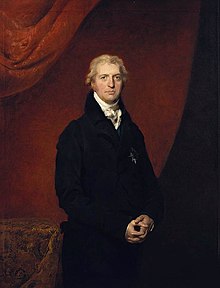
Back روبرت جنكنسون Arabic روبرت جنكنسون ARZ Robert Liverpul Azerbaijani Роберт Джэнкінсан Byelorussian Робэрт Джэнкінсан BE-X-OLD Робърт Дженкинсън, лорд Ливърпул Bulgarian Robert Jenkinson Czech Robert Banks Jenkinson, 2. jarl af Liverpool Danish Robert Jenkinson, 2. Earl of Liverpool German Robert Jenkinson Spanish
This article needs additional citations for verification. (January 2024) |
The Earl of Liverpool | |
|---|---|
 | |
| Prime Minister of the United Kingdom | |
| In office 8 June 1812 – 9 April 1827 | |
| Monarchs | |
| Regent | George, Prince Regent (1812–1820) |
| Preceded by | Spencer Perceval |
| Succeeded by | George Canning |
| Secretary of State for War and the Colonies | |
| In office 1 November 1809 – 11 June 1812 | |
| Prime Minister | Spencer Perceval |
| Preceded by | The Viscount Castlereagh |
| Succeeded by | The Earl Bathurst |
| Leader of the House of Lords | |
| In office 25 March 1807 – 9 April 1827 | |
| Prime Minister |
|
| Preceded by | The Lord Grenville |
| Succeeded by | The Viscount Goderich |
| In office 17 August 1803 – 5 February 1806 | |
| Prime Minister | |
| Preceded by | The Lord Pelham |
| Succeeded by | The Lord Grenville |
| Home Secretary | |
| In office 25 March 1807 – 1 November 1809 | |
| Prime Minister | The Duke of Portland |
| Preceded by | The Earl Spencer |
| Succeeded by | Richard Ryder |
| In office 12 May 1804 – 5 February 1806 | |
| Prime Minister | William Pitt the Younger |
| Preceded by | Charles Philip Yorke |
| Succeeded by | The Earl Spencer |
| Secretary of State for Foreign Affairs | |
| In office 20 February 1801 – 14 May 1804 | |
| Prime Minister | Henry Addington |
| Preceded by | The Lord Grenville |
| Succeeded by | The Lord Harrowby |
| Personal details | |
| Born | Robert Banks Jenkinson 7 June 1770 London, England |
| Died | 4 December 1828 (aged 58) Kingston upon Thames, Surrey, England |
| Resting place | Hawkesbury Parish Church, Gloucestershire, England |
| Political party | Tory |
| Spouses | |
| Parent | Charles Jenkinson (father) |
| Education | Charterhouse School |
| Alma mater | Christ Church, Oxford |
| Signature | |
Robert Banks Jenkinson, 2nd Earl of Liverpool, KG, PC, FRS (7 June 1770 – 4 December 1828) was a British Tory statesman who served as Prime Minister of the United Kingdom from 1812 to 1827. He also held many other important cabinet offices such as Foreign Secretary, Home Secretary and Secretary of State for War and the Colonies. He was also a member of the House of Lords and served as leader.
As prime minister, Jenkinson called for repressive measures at domestic level to maintain order after the Peterloo Massacre of 1819. He dealt smoothly with the Prince Regent when King George III was incapacitated. He also steered the country through the period of radicalism and unrest that followed the Napoleonic Wars. He favoured commercial and manufacturing interests as well as the landed interest. He sought a compromise of the heated issue of Catholic emancipation. The revival of the economy strengthened his political position. By the 1820s, he was the leader of a reform faction of "Liberal Tories" who lowered the tariff, abolished the death penalty for many offences, and reformed the criminal law. By the time of his death, however, the Tory party, which had dominated the House of Commons for over 40 years, was ripping itself apart.
Important events during his tenure as prime minister included the War of 1812 with the United States, the Sixth and Seventh Coalitions against the French Empire, the conclusion of the Napoleonic Wars at the Congress of Vienna, the Corn Laws, the Peterloo Massacre, the Trinitarian Act 1812 and the emerging issue of Catholic emancipation. Despite being called "the Arch-mediocrity" by a later Conservative prime minister, Benjamin Disraeli, scholars rank him highly among all British prime ministers.[1]
- ^ Paul Strangio; Paul 't Hart; James Walter (2013). Understanding Prime-Ministerial Performance: Comparative Perspectives. Oxford UP. p. 225. ISBN 978-0-19-966642-3.
© MMXXIII Rich X Search. We shall prevail. All rights reserved. Rich X Search